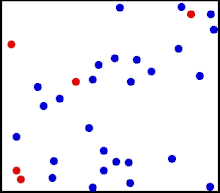File:Translational motion gif with ffmpeg2theora 024.ogv
Translational_motion_gif_with_ffmpeg2theora_024.ogv (Archivo de vídeo Ogg Theora, duración: 19s, 300 × 264 píxeles, 173 kbps, tamaño del archivo: 392 kB)
Leyendas
Leyendas
Resumen
[editar]| DescripciónTranslational motion gif with ffmpeg2theora 024.ogv |
Motion of gas molecules Español: Animación mostrando la agitación térmica de un gas. Cinco partículas han sido coloreadas de rojo para facilitar el seguimiento de sus movimientos.
Русский: Хаотическое тепловое движение на плоскости частиц газа таких как атомы и молекулы |
| Fecha | (original) 2010-04-28 (converted to OGV) |
| Fuente |
Este archivo deriva de: Translational motion.gif English: Converted as follows:
|
| Autor | A.Greg, en:User:Greg L |
| Otras versiones |
 |
Translational motions—the randomized thermal vibrations of fundamental particles such as atoms and molecules—gives a substance its “kinetic temperature.” Here, the size of helium atoms relative to their spacing is shown to scale under 1950 atmospheres of pressure. These room-temperature atoms have a certain, average speed (slowed down here two trillion fold). At any given instant however, a particular helium atom may be moving much faster than average while another may be nearly motionless. The rebound kinetics of elastic collisions are accurately modeled here. If the velocities over time are plotted on a histogram, a Maxwell-Boltzmann distribution curve will be generated. Five atoms are colored red to facilitate following their motions.
Note that whereas the relative size, spacing, and scaled velocity of the atoms shown here accurately represent room-temperature helium atoms at a pressure of 1950 atmospheres, this is a two-dimensional scientific model; the atoms of gases in the real world aren’t constrained to moving in two dimensions in windows precisely one atom thick. If reality worked like this animation, there would be zero pressure on the two faces of the box bounding the Z-axis. The value of 1950 atmospheres is that which would be achieved if room-temperature helium atoms had the same inter-atomic separation in 3-D as they have in this 2-D animation.
Licencia
[editar]| Public domainPublic domainfalsefalse |
| Esta imagen de geometría simple no es protegible por derechos de autor y, por tanto, es de dominio público, ya que está compuesta en su totalidad por información que es propiedad común y no contiene ninguna autoría original. |  |
Historial del archivo
Haz clic sobre una fecha y hora para ver el archivo tal como apareció en ese momento.
| Fecha y hora | Miniatura | Dimensiones | Usuario | Comentario | |
|---|---|---|---|---|---|
| actual | 20:35 28 abr 2010 | 19s, 300 × 264 (392 kB) | 84user (discusión | contribs.) | == {{int:filedesc}} == {{Information |Description=Motion of gas molecules {{es|Animación mostrando la agitación térmica de un gas. Cinco partículas han sido coloreadas de rojo para facilitar el seguimiento de sus movimientos.}} {{ru|Хаотическ |
No puedes sobrescribir este archivo.
Usos del archivo
Las siguientes páginas usan este archivo:
Estado de transcodificación
Actualizar el estado de transcodificaciónUso global del archivo
Las wikis siguientes utilizan este archivo:
- Uso en et.wikipedia.org
- Uso en fr.wikiversity.org
Metadatos
Este archivo contiene información adicional, probablemente añadida por la cámara digital o el escáner usado para crearlo o digitalizarlo.
Si el archivo ha sido modificado desde su estado original, pueden haberse perdido algunos detalles.
| Software usado |
|---|